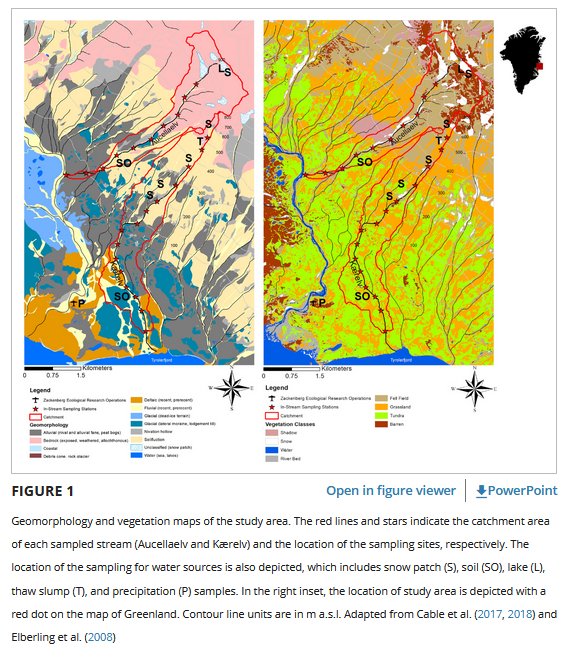Geomorphology and vegetation drive hydrochemistry changes in two Northeast Greenland streams Ada
New publication by Ada Pastor, Louis J. Skovsholt, Kirsten S. Christoffersen, Naicheng Wu, Tenna Riis

Abstract:
Climate change is causing drastic landscape changes in the Arctic, but how these changes modify stream biogeochemistry is not clear yet. We examined how catchment properties influence stream nitrogen (N) and dissolved organic carbon concentrations (DOC) in a high-Arctic environment. We sampled two contrasting headwater streams (10–15 stations over 4.8 and 6.8 km, respectively) in Northeast Greenland (74°N). We characterized the geomorphology (i.e., bedrock, solifluction and alluvial types) and the vegetation (i.e., barren, fell field, grassland and tundra types) cover of each subcatchment area draining into each sampling station and collected water samples for hydrochemistry characterization. The two sampled streams differed in geomorphology and vegetation cover in the catchment. Aucellaelv catchment was mostly covered by a ‘bedrock’ geomorphology (71%) and ‘fellfield’ vegetation (51%), whereas Kæerelv was mostly covered by ‘alluvial’ geomorphology (65%) and ‘grassland’ and ‘tundra’ vegetation (42% and 41% respectively). Hydrochemistry also differed between the two study streams, with higher concentrations of inorganic N forms in Aucellaelv and lower DOC concentrations, compared to Kærelv. The results from the linear mixed model selection showed that vegetation and geomorphology had contrasting effects on stream hydrochemistry. Subcatchments with higher solifluction sheets and limited vegetation had higher nitrate concentrations but lower DOC concentrations. Interestingly, we also found high variability on the production and removal of nitrate across subcatchments. These results indicate landscape controls to nutrient and organic matter exports via flow paths, soil organic matter stocks and nutrient retention via terrestrial vegetation. Moreover, the results suggest that climate change induced alterations to vegetation cover and soil physical disturbance in high-Arctic catchments will affect stream hydrochemistry, with potential effects in stream productivity, trophic relations as well as change of solute export to downstream coastal areas.
